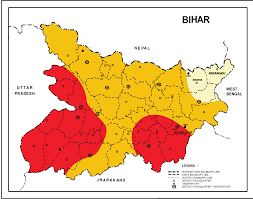The climate of Bihar is characterized by its location in the eastern part of India and its proximity to the Himalayas. The state experiences three main seasons: summer, monsoon, and winter. The climate varies from subtropical to tropical, with significant regional variations due to its diverse topography and geographical features.

- Summer (March to June):
- Summer in Bihar is hot and dry, with temperatures ranging from 35°C to 45°C (95°F to 113°F) or even higher in some regions.
- The state experiences scorching heat during this period, with frequent heatwaves.
- The hot weather can be uncomfortable, and people often seek relief indoors or in shaded areas during the peak hours of the day.
- Monsoon (July to September):
- The monsoon season brings much-needed relief from the scorching summer heat. It usually begins in early July and lasts until September.
- Bihar receives a significant amount of rainfall during this period, with the average annual rainfall ranging from 1,000 mm to 1,400 mm (39 to 55 inches).
- The monsoon is crucial for the state’s agriculture, as it replenishes water bodies and provides irrigation for crops.
- Winter (October to February):
- The winter season in Bihar is generally mild and pleasant, with temperatures ranging from 5°C to 20°C (41°F to 68°F).
- The northern parts of the state, particularly in the regions close to the Himalayas, experience colder temperatures and occasional frost.
- Winter is an ideal time for tourism and outdoor activities in Bihar, as the weather remains comfortable.
Bihar’s climate is influenced by several factors:
- Himalayan Influence: The presence of the Himalayan mountain range in the northern region affects the climate of Bihar. The mountains act as a barrier to cold winds from the north, leading to milder temperatures in winter.
- Gangetic Plain: The majority of Bihar lies in the fertile Gangetic Plain, which experiences a typical monsoon climate. The flat topography of the region contributes to the heavy rainfall during the monsoon season.
- Rivers: The major rivers like the Ganges, Gandak, Kosi, and others that flow through Bihar play a significant role in shaping the climate of the state. The rivers contribute to the humidity levels and also influence the temperature in the adjoining areas.
- Deforestation: The loss of green cover due to deforestation and environmental degradation has an impact on the local climate, leading to changes in rainfall patterns and temperature.
Overall, Bihar experiences a diverse climate with distinct seasonal variations. The hot and dry summers, followed by the refreshing monsoons, and the mild winters make it a region of varying weather conditions, affecting the lives of its people and the state’s economy, particularly agriculture.
- Aw Climate: Tropical Savanna Climate
- This climate type is prevalent in the southern and southeastern parts of Bihar, particularly in the districts bordering Jharkhand.
- The Aw climate is characterized by high temperatures and distinct wet and dry seasons.
- Summers are hot and dry, with temperatures often exceeding 35°C (95°F) during the day. Heatwaves are common during this season.
- The monsoon season, from July to September, brings heavy rainfall to the region, which is vital for agriculture.
- Winters are relatively mild, with temperatures ranging from 10°C to 20°C (50°F to 68°F).
- Overall, the Aw climate is suitable for the cultivation of various crops, and agriculture is an essential economic activity in this region.
- Cwa Climate: Humid Subtropical Climate
- This climate type is prevalent in the northern and northwestern parts of Bihar, including the capital city, Patna.
- The Cwa climate is characterized by hot and humid summers, mild winters, and a distinct monsoon season.
- Summers are hot and humid, with temperatures often reaching 40°C (104°F) or more. The humidity during this season can make the weather uncomfortable.
- The monsoon season, from July to September, brings significant rainfall to the region, which is essential for agriculture and replenishing water bodies.
- Winters are relatively mild, with temperatures ranging from 5°C to 20°C (41°F to 68°F), depending on the location.
- The Cwa climate supports a variety of crops and is favorable for agriculture, contributing significantly to the state’s economy.
Both climate types in Bihar have a strong influence on the state’s agricultural practices and economy. The availability of water resources during the monsoon season allows for the cultivation of a wide range of crops, making agriculture a vital sector for the state’s population. However, the region is also vulnerable to natural disasters such as floods, which are often caused by excessive rainfall during the monsoon season. Adequate management and planning are essential to mitigate the impact of such events on the lives and livelihoods of the people in Bihar.
Important Links